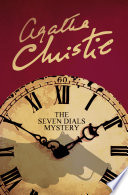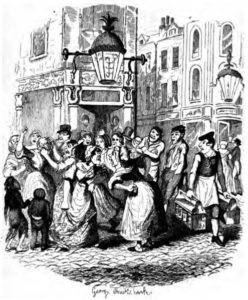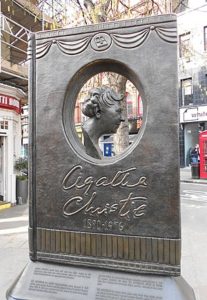
Poirot Score: 55
The Seven Dials Mystery
☆☆
Reasons for the Poirot Score
This has a great deal of humour, mainly from Lord Caterham, which makes the novel a joy to read. There are some fair clues to some parts of the plot, but other pieces of the ultimate solution are arbitrary. It also is a reasonable thriller with a surprising twist at the end.
Click here for full review (spoilers ahead)
Trivia
The Seven Dials area of London.
The Seven Dials area started off as a Restoration development by Thomas Neale, MP, in the 1690s, following on the success of Covent Garden. Neal’s Yard still bears his name. The unusual, innovative design of triangular plots (see map below) was to maximise shop frontage, which would gain a higher rent. Unfortunately the cheap gin shops were this area’s ruin, and from a fashionable aspiration it rapidly slumped into the slum gutter, with rampant crime and prostitution. Charles Dickens had described it a century earlier than Christie: ‘The stranger who finds himself in the Dials for the first time…at the entrance of Seven obscure passages, uncertain which to take, will see enough around him to keep his curiosity awake for no inconsiderable time…’ (Charles Dickens, Sketches by Boz, 1836, with illustrations by Cruikshank). The Seven Dials area of Soho was still a slum area of London where the poor and unwashed scratched out a miserable short life in the 1920s, when Christie was writing this novel.
 Seven Dials caricature by George Cruikshank
Seven Dials caricature by George Cruikshank  Map of Seven Dials Area ( to show the seven streets)
Map of Seven Dials Area ( to show the seven streets)
The Seven Dials also gets a mention in Iolanthe by Gilbert and Sullivan:
‘Hearts just as pure and fair
May beat in Belgrave Square
As in the lowly air of Seven Dials.’
Agatha Christie was a keen Gilbert and Sullivan singer, so would have been familiar with the lyrics.
In the last fifty years this area of London has undergone gentrification, from slum dwellings to bijoux houses for the super-rich. This change in the Seven Dials’ fortune started when it became a ‘trendy’ area of London in the swinging 60s. Brian Epstein, the manager of the Beatles, ran his company from 13 Monmouth Street. The animation, editing and recording studios for the TV comedy Monty Python were in Neal’s Yard. Both these cultural icons are now commemorated by London Blue Plaques. The one in Neal’s Yard says “Monty Python, Filmmaker, lived here, 1976-1987”.
The Pillar in the centre of the Seven Dials 

Thomas Neale commissioned this beautiful landmark from Edward Pierce in 1693. There are sundials on each of its six faces, so the time could be seen from any approach. The seventh dial is the giant pillar itself.
 This Agatha Christie Memorial is appropriately very close to The Seven Dials. It was designed by Ben Twiston-Davies. This area of Soho not only features in many Christie novels, but is also London’s ‘theatre land’. The idea for this London memorial was from Christie’s grandson, Matthew Prichard, and Sir Stephen Waley-Cohen. It was put here in 2012 to celebrate 60 years of Christie’s play The Mousetrap. The Mousetrap ran continuously from 1952-16th March 2020 when St Martin’s Theatre, West Street, had to close due to the Covid-19 pandemic.
This Agatha Christie Memorial is appropriately very close to The Seven Dials. It was designed by Ben Twiston-Davies. This area of Soho not only features in many Christie novels, but is also London’s ‘theatre land’. The idea for this London memorial was from Christie’s grandson, Matthew Prichard, and Sir Stephen Waley-Cohen. It was put here in 2012 to celebrate 60 years of Christie’s play The Mousetrap. The Mousetrap ran continuously from 1952-16th March 2020 when St Martin’s Theatre, West Street, had to close due to the Covid-19 pandemic.
For information about Chimneys, and the real country house that inspired the story, see the Trivia for The Secret of Chimneys on this website.

